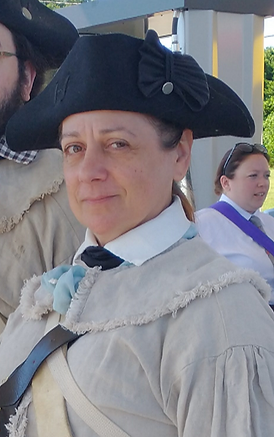
Impressions
Within the 1NJ we strive to represent the diversity of men and women who made up the Continental Army. There are a variety of roles and impressions within reenacting the First: Who will you be?
Soldiers
The 1NJ portrays a line (infantry) Regiment of the Continental Army during the American War for Independence. We recreate the historic tactics, drill and uniforms of the 18th c regiment in battle reenactments, living history events and educational programs.
For our primary 1777 impression you'll see our soldiers in the familiar red-blue uniform colors. Our Regimental coat differs from the familiar uniform by being a coattee, a shorter version of a regimental, with other distinctive details.
An alternative to the regimental coat is the hunting shirt, shown below left, a linen over-shirt, open in front with a fringed cape.


The smallclothes -shirt, waistcoat (equivalent to the modern vest) and breeches or trowsers (long pants) were what the soldiers brought from civilian life. Period shoes, soldiers' accoutrements, and a military cocked hat - the familiar but less historical term was tricorn - round out the uniform.
Occasionally we field as militia, wearing a civilian coat or jacket instead of a regimental or hunting shirt.
The 1st NJ has a detailed clothing guide to help you get started with clothing and accoutrements, whether you prefer to buy or make your kit.
About women in the ranks
Gender rolls were very different and defined in the 18th c. Part of the societal restriction placed on women was that, while women were part of the Continental Army, they were not part of the Army as soldiers... not openly or officially. There are documented cases of women who passed as men, successfully soldiering for part or all of the American War for Independence.
The 1st NJ permits women to field as soldiers who can pass as a man in the ranks, and meet all the requirements set out in our guidelines.
Under Arms
The preferred smoothbore flintlock musket for our soldiers is the .75 caliber 2nd Model Long Land Pattern musket -often called a 'Brown Bess'- or a .69 caliber French Charleville musket. While the Regiment has loaner muskets they are not always available. Members should make arrangements to purchase their own musket as soon as they are able.
We are a line regiment so rifles are not part of our impression, and cannot be carried onto the field with the 1st.
On the Army's Strength
An 18th century army was more than enlisted soldiers. The Continental Army needed to be fed and transported. Its uniforms and clothing needed washing and mending, the ill needed tending, supplies and people needed transportation. The men and women that supported and supplied the army, provided both goods and services were an essential part of what Dr. Holly Mayer calls the “Continental Community”, necessary to the army’s function and success.
Our members bring documented impressions as sutlers (women and men who sold goods) washerwomen, and nurses to reenactments, living history and school programs.


The women who followed the Army were essential to its mission. These intrepid women were a cross section of 18th c. American society and culture, from Martha Washington to the un-named private’s wife. They were soldiers' wives, mothers and children, making their way in camp by working as a seamstress, washerwomen, nurse, sutlers, sometimes as servants to officers and very occasionally as cooks.
The women of the 1st reflect our commitment to historically portraying the Continental Army and our 21st c. commitment to value every member's contribution.

Our surgeon, portraying Dr George McClelland, is one of the few to portray a military regimental flying hospital. Only one other hospital currently in use is as large and detailed: The instruments are both reproductions meticulously crafted from museum pieces or 18th c illustrations, and period antiques. Dr. McClelland (aka Marjy Weinkop) brings three decades of experience and research to presenting 18th century medical and dental practices. Our surgeon is able to reenact everything from after-battle surgical demonstrations to simple bleedings, lecturing about disease and hygiene in the Continental Army, and portraying everyday life in a regimental hospital.






